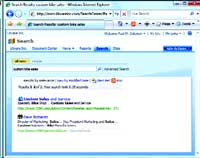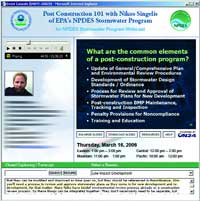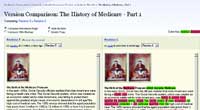Searching your documents with SharePoint is as easy as using a search engine on the Web. Good document handling controls, can link to real-time data streams. Difficult to set up and customize. B A- B- A+Microsoft SharePoint is one of the best-known collaboration tools. The company set the bar with content management and enterprise search tools, and it has raised the bar a little higher with the latest version of this collaborationprogram.SharePoint 2007 aggregates all the virtual content of your organization and lets you store, find and share data with a small group, large team or massiveenterprise.It's the backbone of many organizations because it comes with strong security standards and maintains the flexibility of the Windows rights and permissions capabilities, so you can choose who can see what document, when and for how long. Additionally, you can choose what a user can do with a document: print, copy, edit or just view it.Microsoft did a good job of making sure Office SharePoint Server 2007 supports all intranets, extranets and Web applications enterprisewide in one integrated platform. SharePoint doesn't rely on separate, fragmented systems, so it can take apart several of the silos that stunt organizational productivity at many large agencies.In the same way, this standardization of content management promotes cross-organizational projects because everyone has a standard collaboration platform. And granting access to one another's SharePoint site is as easy as one-two-three. You no longer need to develop an interface for the other agency's proprietary content database or wait weeks for permission in a remote location.Microsoft Office SharePoint Server 2007 gives organizations the ability to deliver information critical to agency objectives through server-based spreadsheets accessing real-time business data and lets you perform sophisticated analyses of key performance indicators through your agency's Web site.SharePoint Server 2007 can effectively implement a forms-based business process, which means users can design and publish forms using the tool, thereby standardizing the reporting process, and they can access all content via basic Web browsers.Also, SharePoint includes the ability to connect with structured systems, such as databases and line-of-business applications.Finally, SharePoint helps teams work together by letting them share information by using wikis and blogs, publishing documents, maintaining task lists, conducting surveys, developing and maintaining site templates customized for specific business uses, and implementing workflows.Despite these benefits, there are areas where SharePoint can improve. Using the software to the fullest extent is challenging, mainly because the interface is difficult to get used to and Microsoft jams so much functionality into the program. Another issue is that there is so much you can do with the software and so many different customizable features that setting up the software to meet your agency's requirements takes a carefully organized approach.At $4,424 per Office SharePoint 2007 server plus $94 per license, Microsoft makes this collaboration tool's bang for the buck hard to beat.Microsoft, (800) 642-7676, www.microsoft.com With ON24, you can create massive, town hall-type meetings with hundreds of participants. Able to bring massive audiences to the same page, simple interface, no software required. Can't host a presentation with anything other than Microsoft Windows Explorer. A- B A A-One of the most important and overlooked types of collaboration tools is mass presentation software. Often called town hall programs, these tools are used to bring a large group of people to the same page on complex topics. Webcast Center from ON24 is an online tool capable of handling conferences and events, training, and public communications via an easy-to-use Internet system.What makes this collaboration tool unique and better than most is that it doesn't require a download or software plug-in regardless of whether you're hosting the presentation or viewing it. Most collaboration software requires a lengthy download and installation, which is usually done right before the meeting or presentation. To say the least, this can be a huge hassle ' and a dire fear if you are to host an important event. I've been part of training modules facilitated by plug-in collaboration software that have gone down in flames because of software download and installation issues. With these types of programs, the fewer steps the better.ON24 did a fantastic job making the interface for Webcast Center effortless to use and navigate. While testing this program, I established a town hall-type presentation and used an incredibly simple method to solicit feedback and suggestions from the mock community of public officials. More important, the program is built so that the host can troubleshoot while the presentation is going on without the crowd or participants being aware of it.Despite these pluses, there's still plenty of room for improvement with Webcast Center. I noticed immediately that the hosting and viewing tool of choice ' the only choice ' is Microsoft Internet Explorer. This limits the versatility of the collaboration tool. I, for example, prefer to use Mozilla Firefox. Despite being able to view an ON24 presentation with Firefox, I can't host one.Likewise, ON24's Webcast Center also isn't Mac compatible. I mentioned to the company that a logical next step is to not only make the software more universal but also create a proprietary Flash-based viewing engine so you can interface with the program regardless of your configuration. ON24 officials seem to agree and are taking steps to become more compliant and compatible.One of the best features of Webcast Center is its General Services Administration price. For $12,090, you get streaming audio or streaming video with slides, one PowerPoint Slide Deck, PDF version of the slide deck for audience download, Q&A, client-branded registration, lobby, an event console and a client option to replace logos on an event-by-event basis.You also get the ability to convert a live presentation to an on-demand event, archival functions good for as long as 90 days, real-time event usage reporting and polling functionality.What makes the Webcast Center price matrix different from most of its competition is that ON24 includes technical support, four hours of training and setup/implementation in the price.ON24, (415) 369-8000, www.on24.com The ThinkTank software can do more than any other program, including detailed survey sending. Most innovative in review, most flexible. Dated interface, a little pricey. B+ A+ B+ B-GroupSystems is giving Microsoft a run for its collaboration software money with ThinkTank. From a systems approach, it's the best true project management collaboration software in the review. Unlike SharePoint, which is essentially a central repository for critical-document sharing, ThinkTank is an interactive, Web-based portal for strategic planning, risk assessment, process improvement, product development, problem solving and requirement gathering.The one noticeable problem with the program is that the interface is dated and needs to be revamped to increase flow during a project-based collaborative effort. Similarly, despite an intuitive wizard that begins with each new session, the interface is still difficult to use because of the large number of possible applications.In theory, ThinkTank is a simple collection of templates your agency can download, upload and use to perform everything from running Six Sigma operations to brainstorming initiatives to solving some of your department's biggest issues. It removes the silos that often exist in large enterprises because it helps standardize and socialize the thought processes behind complex project management issues.ThinkTank can also let you create and run sessions to discuss action items that you've built using the software and template methodologies. In these sessions, you can hold and maintain documents as in SharePoint, keep a roster and agenda, administer permission settings, and create time schedules to meet as frequently and for as long as you chose.The ThinkTank architecture is pretty straightforward. From the client side, any operating system/Web browser combination that supports Adobe Flash Version 8.0+ can be used to connect to the ThinkTank server using HTTP or HTTP Secure. Then, a Windows Server 2003 operating JBoss 4.0.3+ and MySQL 5.0.24 hosts the ThinkTank software you connect to. Finally, Extensible Markup Language application programming interfaces or SQL is used to process a report, an application such as IBM SameTime or Web conferencing, or run a MySQL query.The security features are the best part of the ThinkTank tool. An optional log-in with Secure Sockets Layer for 128-bit encryption is available. Certificates by Thawte are administered, leader passwords are masked and encrypted, the session leader sets the session passkey, and the server is physically located at Rackspace.com.There is no physical access to the data, but it is well-protected. The server farm offers the latest fire suppression technology in addition to diesel and battery backup power with three redundant communications providers and a Cisco Systems PIX 506E firewall, in which only ports 80 and 443 are allowed. Finally, around-the-clock intrusion detection is on-site, and nightly incremental backups and weekly full backups are administered.The price of $5,000 per 10 clients is high, but it gets a lot better with the 20 percent government discount.Group Systems, (800) 368-6338, www.groupsystems.com Clearspace is the easiest program in the review to use and also happens to be the least expensive. If you have fewer than five users, it's free. Easiest to setup in review, personalized content space views, only $29 per user and free for as many as five users. Nothing significant in the latest version. A A A AIf your agency or organization depends heavily on collaborative effort by users in multiple states or even countries, then you need something like Clearspace 1.5 in your enterprise.Clearspace is a direct competitor to SharePoint, and we found it a lot more versatile and easier to use. The software is hierarchically organized and lets you organize by topic rather than content type so project material is easier to get to, and the software overall is easier to learn and navigate.Also, the software limits spaces to certain types of content so less junk is archived in your network, and the space-level access control lets you determine what type of data you want to keep.One flaw with the software used to be the inability to personalize the content and view of the interface; however Version 1.5 lets you personalize all content views.Setup is by far the easiest in the review. Download Clearspace and deploy it by using the Windows installer. You can also elect to start the embedded application server or deploy it to your own server. From there, you simply begin to name the workspaces or communities. Add your acceptable content types plus permissions, and you're done.Jive Software takes advantage of the latest Web-based technologies, too.One of its best features is Clearspace Really Simple Syndication watches, which feed you constant updated digests of content changes that are most important to your agency, including specific discussions, blogs, documents andpersonnel.With Clearspace, you can quickly create collaborative subject-matter-expert documents that resemble wiki documents.You can also upload files, such as Word or Excel documents that are critical to your projects. Clearspace's documents support rich-text and wiki markup for powerful formatting and in-line editing.You can also attach text files, images, audio and video for better descriptions of your projects or to facilitate training.And best of all, you can find everything quickly with tags. Clearspace lets you tag all content so it's easy to find and organize. You can find related content through individual tags or browse the full tag cloud.You can even check out other users' personal tag clouds to see what topics are most important to them. And if you group tags to find relevantcontent, you can track versions of a document and compare the changes side-by-side if necessary.Clearspace lets you create a private draft of a document, then co-author it with others by adding those you want to look at it to the list. Then after getting it reviewed, you can publish it to your entire agency.You can even receive posted comments from users about the final document and track all edits via e-mail or RSS.Likewise, you can receive e-mail notifications any time someone posts to or modifies content that interests you. You can reply to a discussion thread through e-mail and have your content captured in Clearspace.Clearspace easily adds links inside the content, too. These links connect one piece of content to another, and the more you link content, the greater your team's depth of knowledge will be.In addition, less information will be duplicated, which is a huge problem with SharePoint in most organizations. It's like a data attic: You often find the same organizational chart in 12 different places. But that won't happen here.And this link system isn't the only way Clearspace saves time. Clearspace analyzes content, including attachments, and automatically suggests related content.Finally, server-side Java and caching make Clearspace fast. Because it supports clustering based on Coherence technology, it can be deployed on multiple servers to offer scalability and fault-tolerance. And the administrative console includes role-based access rights. Permission checking is done at the Java method level to guarantee the right access to content.But perhaps the best part of Clearspace is the price tag, which is only $29 per user with a minimum of 25 users. For as many as five users, the service and software are free.Jive Software, (877) 495-3700, www.jivesoftware.com
Collaboration software makes your agency go round. No matter what projects or task lists you need to tackle, one of the most important programs in any organization is the collaboration software that helps everyone work well together regardless of location. The simple fact is that people spend most of their work time in meetings and as members of teams. A good collaboration tool can apply this time toward completion of a project rather than frittering it away in yet another wasted meeting. By contrast, a poor collaboration tool can undermine your project's objectives, making boring meetings worse than nothing at all.
Understanding collaboration programs is tough, and choosing the best one for your organization can be even tougher. To find and employ the best collaboration tools, you need to understand two things: the nature of collaboration tools and the specific needs of your agency.
Complementary by design
Each tool is, by design, fairly complementary with other collaboration platforms.
There are no all-in-one solutions that you can or should use. Many organizations I have worked in use a collection of collaboration tools. One tool might be for holding and centralizing important project-based documents, another for phone meetings and yet another for remote presentations.
It's important to note that the term collaboration software is ambiguous and
amorphous.
Technically, Microsoft Outlook is a collaboration tool because you can not only communicate with it but also share and centralize schedules across your working environment.
The type of hierarchy in which multiple collaboration tools are employed at the same time has the drawback of being challenging to learn.
But this system works well because it keeps you from placing all your eggs in one basket ' especially in one that can crash just as you're about to deliver a major presentation or need to send a mission-critical instant message.
Many critics claim an all-in-one solution is the most cost-effective. However, for midsize to large organizations, the cost of collaboration tools is shared across budget centers and multiple divisions because everyone uses them. So the cost to each division is often minimal. And because collaboration software by definition is any tool that organizes and facilitates the dissemination of information internally, collaboration programs take precedence as one of the most important features of an organization.
The other key to finding the best collaboration tool for your enterprise is to have your finger on the pulse of your agency. There are so many different collaboration-based services and programs available that it's important to know what fits best with the style of your agency. For example, some federal agencies are primarily interested in data integrity. A completely Web-based tool or one supplied by a third party might not be the best choice for them because such systems can be more easily compromised than a suite that exists inside the firewall.
And if your agency doesn't have instructional technology employees who can facilitate enrollment and training on the collaboration systems, it is important to choose a tool that is easy to use.
Plan for the future
A subset of this step is taking into account organizational growth, standardization and future technological trends. Many collaboration suites have limits on the number of participants who can use the software at one time. So, if your agency is involved in large cross-divisional projects, for example, you'll probably want to choose software that can expand with your user base.
Compliance is another issue to keep in mind. It is important that the collaboration software complies with your security standards and that it is used in a way compliant with other standards. For example, in some working environments, it is important to disable functions such as file sharing or remote desktop control features. All too often, enterprises neglect to cancel such features, which employees take advantage of to transmit sensitive or nonpertinent materials across these lines of communication.
More important, compliance can also refer to Section 508 of the Rehabilitation Act, which mandates that agencies use information technology products and services that allow people with disabilities to use them. Collaboration software is a perfect candidate for Section 508 compliance.
So before you sign on the dotted line, make sure, for instance, that the software has features such as hot keys or keyboard short-cuts so a mouse is not mandatory for those who have diminished mobility or limited use of their hands or arms. Likewise, it should be possible to increase the font size so vision-impaired people can use it. Collaboration software that can convert text to audio and can function by voice-activated commands should get bonus points.
The final item to consider is the likely future of the technology your agency uses. For example, one company I used to work for spent a small fortune on a suite of collaboration tools that functioned with the then-current system of telephony only to find that the tools would become obsolete in a year when the company completed its transition to voice over IP.
For this review, we examined the major players' collaboration programs by taking a look at the ease of use, performance and functionality of each suite. We rated each program by analyzing how intuitive its interface is, especially when navigating or troubleshooting a problem that occurs while hosting a meeting or running a presentation.
Additionally, each program gained points for functionality ' such as its ability to display images and text and be viewed through more than just a Microsoft Internet Explorer prompt ' and compliance with several standards. Lastly, we measured the software's ability to give the host as many options as possible during a collaborative meeting or presentation. These features, coupled with price, constitute the overall grade.
NetMeeting vs. WebEx vs. Web Meeting vs.'?
One important side note to this review is the
obvious and intentional absence of a common subset of collaboration software ' small virtual presentation tools. These programs, such as Microsoft NetMeeting, WebEx Communications, AT&T Web Meeting and many others, are simple, dime-a-dozen technologies that are often free to use.
Despite their importance in most organizations, they are all similar and offer few distinguishing characteristics aside from aesthetics. This mature technology lies outside the scope of this review, which is intended to focus on large, enterprise collaborative programs that can be difficult to choose, purchase and use.
That isn't to understate the importance of such presentation tools. They are useful in getting quick points across to a handful of participants or training a dozen people on a simple topic or group of ideas.
But they all suffer from similar issues, such as the need to download and install software plug-ins before joining a meeting or dedicate a lot of bandwidth to minimize the often substantial lag time between the host of the meeting and the participants.
Likewise, each is just as reliable as the next and just as easy to use.










